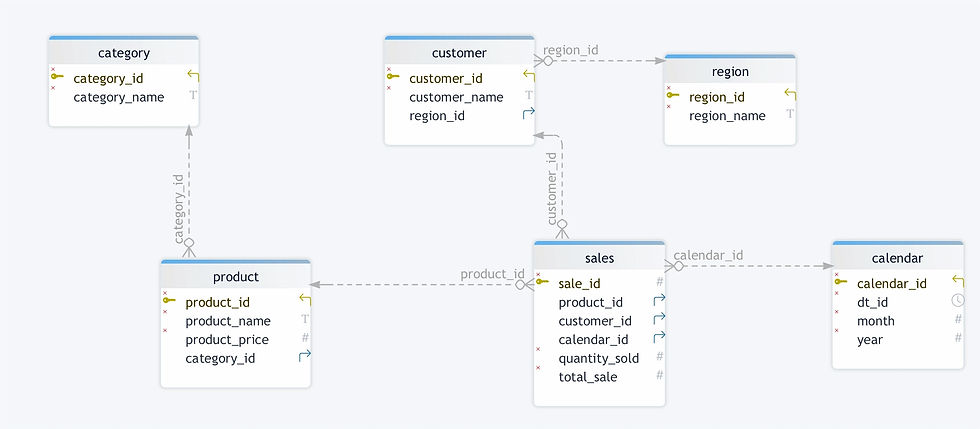Understanding the Distinctions Between Dimensional and Normalized Data Modeling with Practical Examples
- Claude Paugh

- Aug 9
- 4 min read
Data modeling plays a vital role in how organizations design and manage their databases. It shapes how data is stored, retrieved, and analyzed. Two primary approaches dominate this field: dimensional data modeling and normalized data modeling. Each method has its own strengths and use cases, making them suitable for different types of applications. In this post, we will break down the differences between these two modeling techniques and provide practical examples to illustrate their applications in a straightforward manner.

What is Dimensional Data Modeling?
Dimensional data modeling is often used in data warehousing and business intelligence. This approach emphasizes making data easy to retrieve for analysis. At its core, it aims to create a structure that is user-friendly, allowing quick access to insights.
Key Features of Dimensional Data Modeling
Star Schema: One of the most popular layouts in dimensional modeling is the star schema. This model features a central fact table surrounded by dimension tables. The fact table holds quantitative data—like sales revenue—while the dimension tables give additional context (such as product type, time periods, and customer details).
Denormalization: In dimensional models, data is often denormalized. This means data may be duplicated across tables to speed up query performance. For example, a product's details may appear in both its dimension table and within the fact table.
User-Friendly: These models are designed to be intuitive. Business users who are not technical can easily generate reports and draw insights without needing extensive training.
Example of Dimensional Data Modeling
Imagine a retail store keen on analyzing its sales performance. A dimensional model could look like this:
Fact Table: `Sales`
- Columns: `Sale_ID`, `Product_ID`, `Customer_ID`, `Calendar_ID`, `Product_Sale_Units`, `Product_Sale_USD`
Dimension Tables:
- `Product`
- Columns: `Product_ID`, `Product_Name`, `Category`, `Price`
- `Customer`
- Columns: `Customer_ID`, `Customer_Name`, `Region`, `Age_Group`
- `Calendar`
- Columns: `Calendar_dim_SID`, `Date`, `Month`, `Year`,`Day_of_Month`, `Day_num_of_year`

For example, the `Sales` fact table captures all transactions. Meanwhile, the `Product`, `Customer`, and `Calendar` dimension tables add context, enabling users to explore questions like "What were the total sales for each category during 2023?"
What is Normalized Data Modeling?
Normalized data modeling is structured to minimize data redundancy and ensure data integrity. It is commonly found in transactional databases where efficient data management is key.
Key Features of Normalized Data Modeling
Normalization: This process organizes data into related tables to reduce duplication. Each table typically represents one entity. Relationships among tables are maintained through foreign keys, ensuring clarity and consistency.
Complex Queries: While normalized models help eliminate redundancy, they often lead to more complex queries that require multiple joins for data retrieval. In larger databases, this can sometimes slow down performance.
Data Integrity: Normalization helps keep data accurate and consistent. This means that during updates, deletions, or new entries, data integrity is preserved, preventing errors.
Example of Normalized Data Modeling
Using the same retail business scenario, the normalized model might look like this:
Table: `Sales`
- Columns: `Sale_ID`, `Product_ID`, `Customer_ID`, `Calendar_ID`, `Quantity_Sold`, `Total_Sale`
Table: `Product`
- Columns: `Product_ID`, `Product_Name`, `Category_ID`, `Price`
Table: `Category`
- Columns: `Category_ID`, `Category_Name`
Table: `Customer`
- Columns: `Customer_ID`, `Customer_Name`, `Region_ID`
Table: `Region`
- Columns: `Region_ID`, `Region_Name`
Table: `Calendar`
- Columns: `Calendar_ID`, `Date_ID`, `Month`, `Year`

In this example, the `Product` table connects to a separate `Category` table, allowing for comprehensive data management with less duplication. Queries, however, might require more joins to relate the information effectively.
Comparing Dimensional and Normalized Data Modeling
Purpose and Use Cases
Dimensional Data Modeling: This approach shines in analytical scenarios, particularly in data warehousing and business intelligence. Its design is aimed at quick query performance and ease of access for users.
Normalized Data Modeling: This is better suited for transactional systems, where the focus is on data integrity and minimizing redundancy. It's commonly leveraged in operational databases that undergo frequent updates.
Performance
Dimensional Models: They typically provide better performance for read-heavy operations. This outcome is because they reduce the number of table joins necessary during data retrieval.
Normalized Models: While these models can experience slow performance for read operations due to multiple joins, they excel in maintaining data integrity and speed during write operations.
Complexity
Dimensional Models: These are generally simpler and more user-friendly. They allow non-technical users to generate insights and reports without much difficulty.
Normalized Models: These can be complex due to the relationships among tables, making navigation challenging for users who lack technical expertise.
When to Use Each Model
When to Choose Dimensional Data Modeling
Business Intelligence Needs: If your organization heavily relies on analysis and reporting, a dimensional model is ideal.
User-Friendly Access: When the target users are non-technical, and you want them to access data easily and efficiently.
High Query Performance: If your application requires fast query responses, dimensional modeling is the right choice, especially for larger datasets.
When to Choose Normalized Data Modeling
Transactional Systems: If maintaining data integrity and minimizing redundancy are your top priorities.
Frequent Updates: Normalized models are beneficial when your application frequently processes updates, deletions, or new entries.
Complex Relationships: If your data includes intricate relationships that need careful management, normalization helps structure it effectively.
Final Thoughts
Grasping the differences between dimensional and normalized data modeling is essential for organizations looking to refine their data management strategies. Dimensional modeling proves beneficial in analytical contexts by enabling user-friendly access and faster queries. On the opposite end, normalized modeling supports transactional environments by ensuring data integrity and minimizing redundancy.
Consider your organization's specific needs and data characteristics to determine the best modeling approach. Leveraging the right data model can significantly boost data management efficiency and improve decision-making capabilities.

In summary, both dimensional and normalized data modeling have unique attributes. The choice between them should align with your data environment's requirements and your team's technical aptitude. With the right model in place, organizations can enhance their data practices and foster better decision-making.
